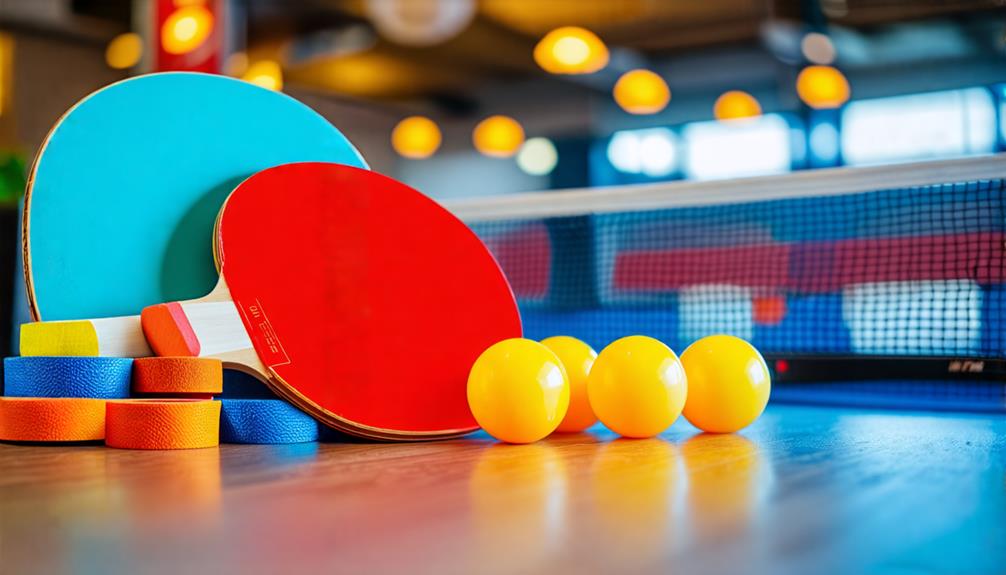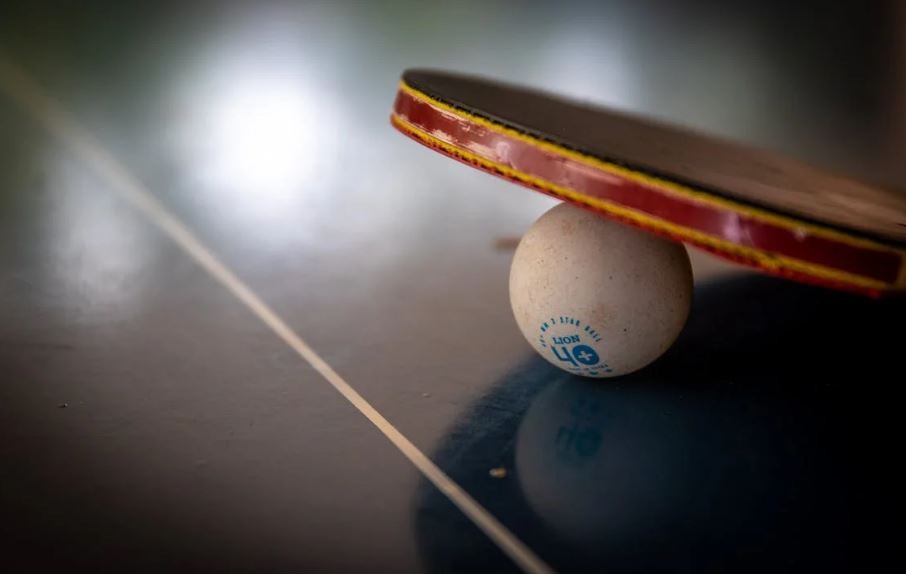How High of a Ceiling Do You Need for Ping Pong?
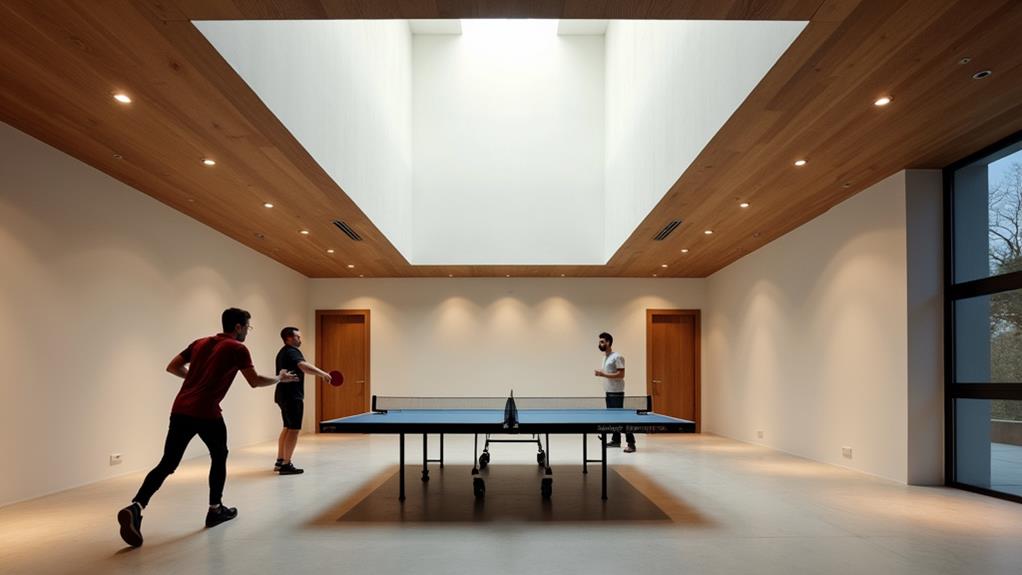
For an enjoyable ping pong experience, you'll need a minimum ceiling height of 10 feet. This height allows for dynamic gameplay, including smashes and lobs, without worrying about hitting overhead fixtures. Ideally, you should also have at least 3 feet of clearance above the table to guarantee unobstructed play. Lower ceilings can limit your shot variety and disrupt the flow of the game. Best setup includes proper lighting and sufficient space around the table, enhancing your comprehensive gameplay. While recreational play can get by with slightly lower ceilings, higher ones certainly benefit competitive matches. Explore more about maximizing your ping pong space.
Standard Ping Pong Table Dimensions
When setting up a ping pong area, it's essential to know the standard ping pong table dimensions, which are 9 ft long, 5 ft wide, and 2.5 ft high. These dimensions are specified by the International Table Tennis Federation (ITTF) to guarantee regulation gameplay. Adhering to these standards helps maintain the integrity of the game and supports peak play.
To achieve the best playing experience, you should consider the ceiling height. A minimum ceiling height of 10 ft is recommended. This height prevents interference with flying balls and allows players to perform different shots effectively, including smashes and lobs. Furthermore, having a clearance above the table of at least 3 ft (90 cm) guarantees safety and unobstructed play.
Higher ceilings are particularly beneficial in competitive environments, where the range of shots and dynamics can be more intense. Smashes and lobs require ample vertical space to execute properly, and a higher ceiling accommodates these aggressive plays better. By following these guidelines, you create an environment conducive to both casual and competitive gameplay, aligning with ITTF standards and enhancing the complete ping pong experience.
Minimum Room Size Requirements
To guarantee a proper ping pong setup, you'll need to take into account the minimum room size requirements. A standard ping pong table size is 9 ft long by 5 ft wide, but to guarantee adequate movement, your playing space needs to be larger. The minimum room size recommended for a standard table tennis setup is about 19 ft long and 11 ft wide. This allows for a clearance of at least 5 ft behind each end of the table and 3 ft on each side. Such clearance around the table guarantees comfortable gameplay and minimizes the risk of accidents.
For those with limited space, smaller table tennis tables offer a practical solution. In this case, the minimum room dimensions can be adjusted to approximately 12 ft by 8 ft. This still provides enough room for enjoyable play while accommodating reduced space. Furthermore, keep in mind that the ceiling height should ideally be at least 10 ft, although this will be discussed further in our next subtopic.
Ideal Ceiling Height
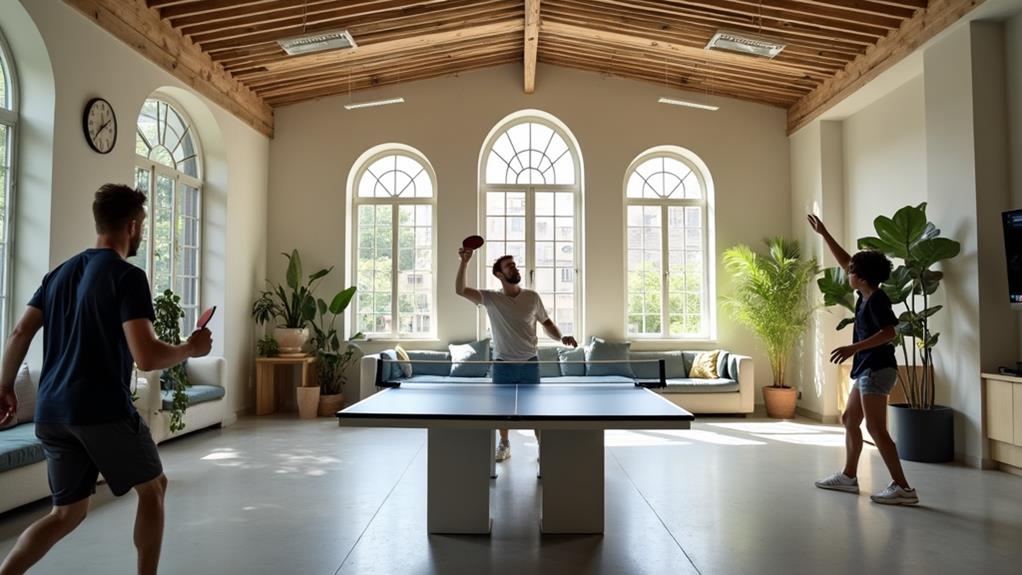
While room dimensions greatly impact your ping pong experience, the ceiling height plays a comparably significant role. When playing ping pong, the ideal ceiling height is at least 10 feet (3 meters). This height guarantees unobstructed play, allowing you to make high shots without worrying about hitting the ceiling.
Standard ping pong tables stand at 2.5 feet tall. Given this, a higher ceiling is vital to prevent interference from overhead fixtures. You wouldn't want your game disrupted by a low-hanging light or fan. Sufficient vertical space is necessary for enhancing your gameplay, especially when executing smashes and lobs. These techniques require ample room above the table, and a higher ceiling lets you utilize a wider shot variety.
To create an ideal room for ping pong, always check for hanging fixtures or other obstacles that could disrupt play. Confirming a clear vertical space above the table is key to maintaining smooth gameplay. Low ceilings can seriously hinder your ability to play effectively, limiting your shot variety and making it tough to perform certain strokes. Therefore, prioritizing an adequate ceiling height is vital for a favorable playing environment.
Effects of Low Ceilings on Gameplay
Imagine gearing up for an intense ping pong match only to find your shots constantly thwarted by a low ceiling. When the ceiling height is too low, it severely limits the vertical space available for smashes and lobs, crucial components of a dynamic gameplay. A recommended minimum ceiling height of 10 ft guarantees unobstructed play, allowing you to fully utilize a variety of shots without worrying about the ball hitting overhead fixtures.
Low ceilings can lead to frequent interruptions, as you might have to dodge or retrieve balls caught in low-hanging fixtures. This not only disrupts the flow of the game but also forces you to adjust your playing style, often making the game less enjoyable and competitive. The risk of damaging light fixtures and other overhead elements increases in rooms with low ceilings, adding to the hazards during intense matches.
Lighting and Fixtures
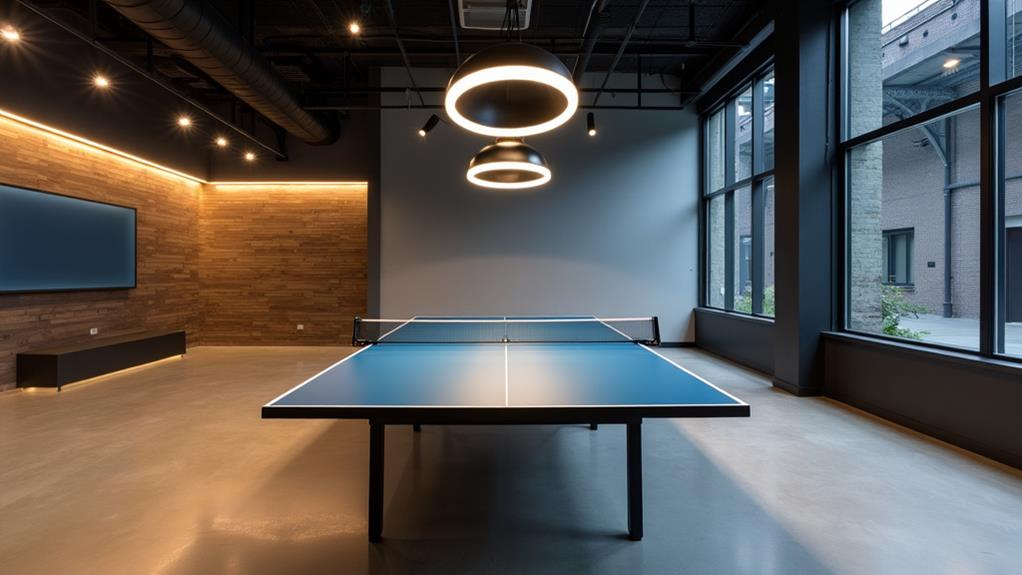
When setting up a ping pong area, lighting and fixtures play an indispensable role in enhancing gameplay. A minimum ceiling height of 10 feet is recommended to guarantee that the ball moves unobstructed during rallies. To achieve peak lighting, place fixtures at least 3 feet above the table. This height prevents interference with gameplay and reduces the risk of damage to the fixtures.
Proper lighting placement is vital. It avoids glare on the playing surface, which can impact your visibility and overall performance. To guarantee even illumination, install overhead lights that cover the entire playing area. This helps create a more enjoyable playing environment by enhancing visibility.
Additionally, avoid hanging decorations or fixtures within 3 feet of the playing area. This precaution allows players ample vertical space for executing shots and movements. Keeping this vertical space clear is fundamental for maintaining the flow of the game and preventing any obstructions.
Space for Professional Play
For those aiming to set up a professional-grade ping pong area, understanding the space requirements is essential. The International Table Tennis Federation (ITTF) recommends a minimum ceiling height of 5 meters (approximately 16.4 feet) to guarantee unobstructed gameplay. This height is vital for allowing smashes and lobs without any interference from overhead fixtures.
Having an adequate clearance above the table prevents disruptions, making your space suitable for competitive play. Low ceilings can greatly hinder the game, as flying balls may hit overhead lights or decorations, breaking the flow of the match.
Professional tournament spaces typically require dimensions of 14 meters long by 7 meters wide. Such dimensions, paired with the recommended ceiling height, create the ideal environment for competitive play styles. Confirming you have this space for playing means you'll adhere to the standards set by the ITTF, providing the best conditions for serious matches.
Small Room Adaptations
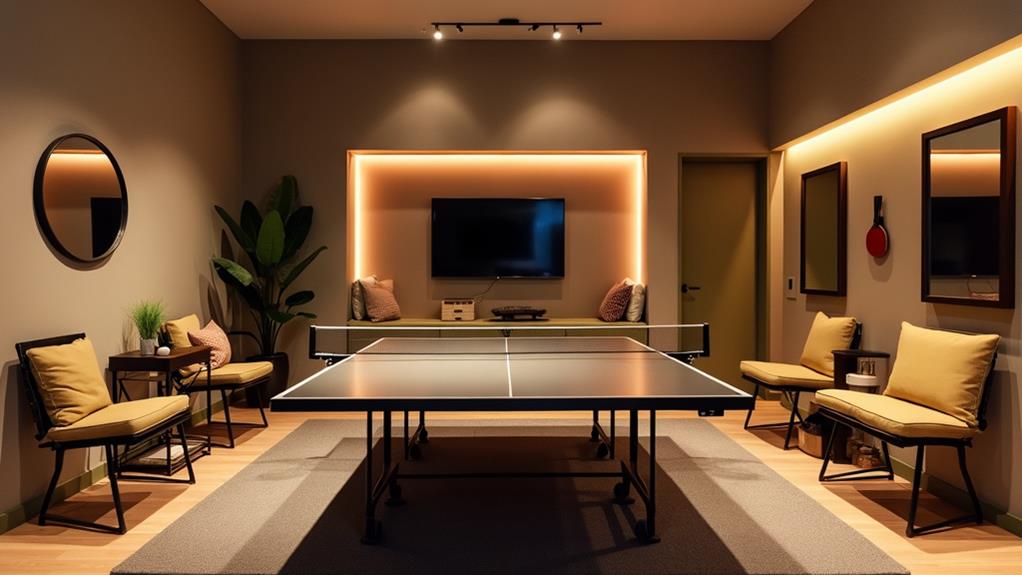
Adapting a ping pong setup for a small room requires a bit of creativity and flexibility to guarantee enjoyable gameplay. Initially, aim for a ceiling height of at least 9 ft (2.75 m) to allow for unobstructed play, especially for high shots like smashes and lobs. If your ceiling's lower, consider using a half-table setup or smaller tables. This adjustment reduces the need for vertical clearance and makes playing in a small space more feasible.
Ensure there's at least 3 ft (90 cm) clearance above the table to avoid interference from light fixtures or other overhead obstacles. This clearance helps maintain an unobstructed play area. Compact training aids like practice nets and rebound boards are excellent for small room adaptations. They improve skill development without requiring much vertical space.
While setting up, be mindful of obstacles around the area. Move breakable items out of the way to prevent accidental damage from exuberant shots. By carefully considering ping pong table dimensions and utilizing compact training aids, you can transform even a small room into a functional and enjoyable ping pong space. Remember, a little creativity goes a long way in adapting to a small room.
Outdoor Table Considerations
Setting up an outdoor ping pong table comes with its unique set of considerations to guarantee ideal play and durability. Initially, confirm you have a minimum clearance of 3 feet above the table. This space accommodates high shots and keeps gameplay smooth. For outdoor play, aim for a ceiling height of at least 10 feet. This prevents interference from overhead hazards like tree branches or structures.
Next, focus on the playing surface. Your area should be level and free from hazards to maintain safety and ascertain the table's stability. Weather conditions are another vital factor. An outdoor table must withstand elements like rain, sun, and wind. Opt for a table designed explicitly for outdoor use, which features weather-resistant materials to extend its lifespan and preserve the quality of your gameplay experience.
Don't forget about lighting. Adequate lighting is important, especially if you plan on playing in the evening. Good lighting improves visibility and reduces the chances of accidents or misplays in dim conditions. By addressing these considerations, you'll create an ideal environment for outdoor table tennis that guarantees safety, comfort, and enjoyable gameplay.
Final Space Recommendations
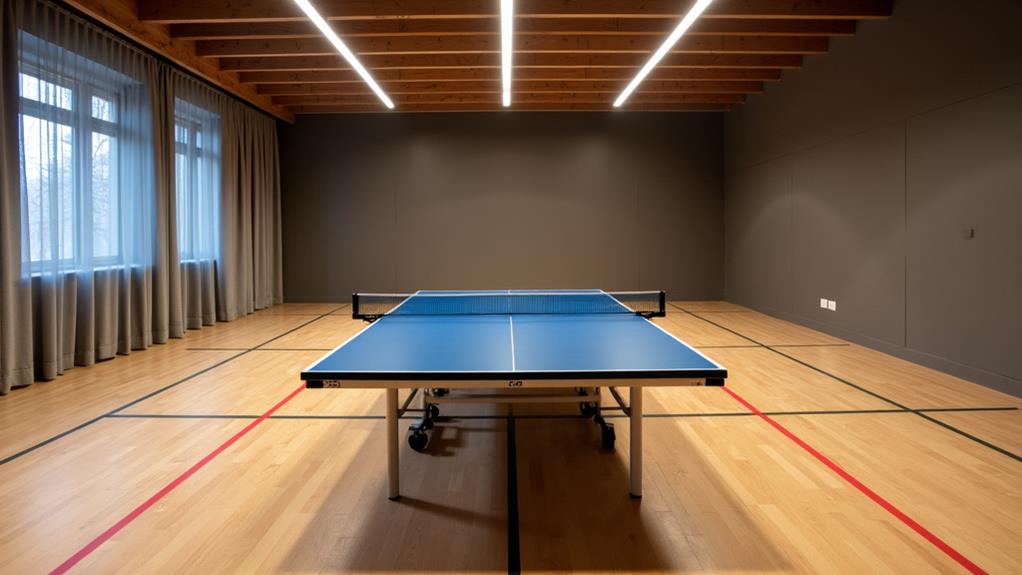
As for final space recommendations for setting up your ping pong area, you'll want to guarantee your environment supports dynamic and enjoyable gameplay. An ideal ceiling height of at least 10 feet (3 meters) is essential for ideal play, making certain unobstructed ball movement during intense rallies. This height allows you to investigate a full range of strokes, including smashes and lobs, without restrictions.
For recreational play, a minimum ceiling height of 9 feet (2.75 meters) can suffice, but keep in mind that higher ceilings are always better, especially for advanced techniques. To avoid interference from light fixtures or ceiling decorations, maintain at least 3 feet (90 cm) of clearance above the table. This setup will greatly improve your gameplay experience, providing ample room for varied and dynamic shots.
When planning your room size, prioritize unobstructed movement around the table. Adequate space guarantees you can execute fast-paced maneuvers and strategic plays comfortably. By adhering to these guidelines, you'll create an ideal table tennis environment that fosters skill development and enjoyment for players of all levels. Consider these factors carefully to optimize your ping pong area's potential.
